Nature Diary Rocks History Gallery Links Home Page   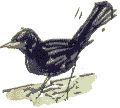 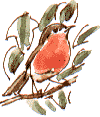 HOUSE SPARROWS come to the nut feeder, as does a Greenfinch. One cock sparrow arrives with a one foot long dry floppy plant stem in his beak, pauses on the perch of the feeder, rests the stem in front of him for a moment, then picks it up and flies off again. Evidently they keep adding to their nests throughout the year. A Blackbird, one of four in the garden, swoops in to peck at crumbs of cheese rind. The Golden Hornet crab apple tree is a favourite perch for them too. Each evening, as the light fades, the Robin is the last visitor on the bird table.
   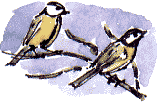 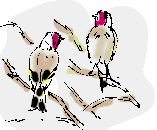 A single Long-tailed Tits favours the tops of the garden hedge shrubs while a Wren gets down to search at the edge of the patio and amongst the herbs. Great Tits continue to visit the garden, but they're not yet regulars on the peanut feeder.
A single Long-tailed Tits favours the tops of the garden hedge shrubs while a Wren gets down to search at the edge of the patio and amongst the herbs. Great Tits continue to visit the garden, but they're not yet regulars on the peanut feeder.
Magpies usually avoid the gardens. They are probably aware what kind of a reception they would get from most gardeners. I clear out the old teapot, attached to the shed amongst the ivy, that served as a nestbox for the robins. The nest is a swirl of moss and stiffish, hair-like plant fibres, with one or two leaves near the bottom.
Unfortunately digging creates the disturbed soil that coltsfoot likes. It is impossible not to break the roots while weeding, so plenty of fragments are left in the soil, ready to grow again. By roots I actually mean the rhizomes, the creeping underground stems.
|
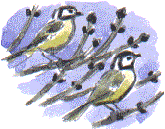
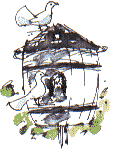
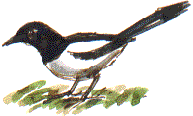 Next door's Fantail pigeons, three of them at the moment, spend most of their time perching on their barrel nestbox. I don't think I've ever seen them come down in our garden, but they often fly over the meadow and perch in the trees in the wood. For a while in the summer they would go and perch on the pylon wires.
Next door's Fantail pigeons, three of them at the moment, spend most of their time perching on their barrel nestbox. I don't think I've ever seen them come down in our garden, but they often fly over the meadow and perch in the trees in the wood. For a while in the summer they would go and perch on the pylon wires. Time to weed out the raised bed behind the pond again. There are almost as many Coltsfoot roots as there were when I dug it at Easter. We grew a good crop of courgettes here during the summer, but I neglected to keep the weeds under control, relying on the broad leaves of the courgette to shade them out. Someday I'll catch up with them.
Time to weed out the raised bed behind the pond again. There are almost as many Coltsfoot roots as there were when I dug it at Easter. We grew a good crop of courgettes here during the summer, but I neglected to keep the weeds under control, relying on the broad leaves of the courgette to shade them out. Someday I'll catch up with them.